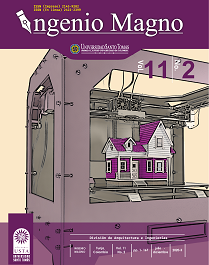Caracterización del proceso de pirólisis de residuos de poliestireno expandido
Contenido principal del artículo
Resumen
Descargas
Detalles del artículo
DECLARACIÓN DE ORIGINALIDAD DE ARTÍCULO PRESENTADO
Por medio del presente documento, certifico(amos) que el artículo que se presenta para posible publicación en la revista institucional INGENIO MAGNO del Centro de Investigaciones de Ingeniería Alberto Magno CIIAM de la Universidad Santo Tomás, seccional Tunja, es de mi (nuestra) entera autoría, siendo su contenido producto de mi (nuestra) directa contribución intelectual y aporte al conocimiento.
Todos los datos y referencias a publicaciones hechas están debidamente identificados con su respectiva nota bibliográfica y en las citas que se destacan como tal. De requerir alguna clase de ajuste o corrección, comunicaré(emos) de tal procedimiento con antelación a los responsables de la revista.
Por lo anteriormente expresado, declaro(amos) que el material presentado en su totalidad se encuentra conforme a la legislación aplicable en materia de propiedad intelectual e industrial de ser el caso, y por lo tanto, me(nos) hago (hacemos) absolutamente responsable(s) de cualquier reclamación relacionada a esta.
En caso que el artículo presentado sea publicado, manifiesto(amos) que cedo(emos) plenamente a la Universidad Santo Tomás, seccional Tunja, los derechos de reproducción del mismo.
Citas
Y. Zhang, D. Duan, H. Lei, E. Villota and R. Ruan, “Jet fuel production from waste plastics via catalytic pyrolysis
with activated carbons,” Applied Energy, vol. 251, pp. 1-17, 2019.
N. Sophonrat, L. Sandström, I. N. Zaini and W. Yang, “Stepwise pyrolysis of mixed plastics and paper for
separation of oxygenated and hydrocarbon condensates,” Applied Energy, vol. 229, pp. 314-325, 2018.
S. M. FakhrHoseini and M. Dastanian, “Predicting Pyrolysis Products of PE, PP and PET Using NRTL Activity Coefficient Model,” Hindawi Journal of Chemistry, pp. 1-5, 2013.
S. D. A. Sharuddin, F. Abnisa, W. M. A. W. Daud and M. K. Aroua, “A review on pyrolysis of plastic wastes,” Energy
Conversion and Management, vol. 115, pp. 308-326, 2016.
A. Sobko, “Generalized Van der Waals-Berthelot equation of state,” Doklady Physics, vol. 53, no. 8, pp. 416-
419, 2008.
J. A. Onwundili, N. Insura and P. Williams, “Composition of products from the pyrolysis of polyethylene
and polystyrene in a closed batch reactor: Effects of temperature and residence time,” Journal of Analytical
and Applied Pyrolysis, vol. 86, no. 2, pp. 293-303, 2009.
L. Quesada, M. Calero, M. Martín-Lara, A. Pérez and G. Blázquez, “Characterization of fuel produced by pyrolysis of plasticfilm obtained of municipal solid waste,” Energy, vol. 186, pp. 1-9, 2019.
S. M. Al-Salem, “Thermal pyrolysis of high density polyethylene (HDPE) in a novel fixed bed reactor system for
the production of high value gasoline range hydrocarbons (HC),” Process Safety and Enviromental Protection,
vol. 127, pp. 171-179, 2019.
J.-L. Shie, J.-P. Lin, C.-Y. Chang, D.-J. Lee and C.-H. Wu, “Pyrolysis of oil sludge with additives of sodium and potassium compounds,” Resources, Conservation and Recycling, vol. 39, no. 1, pp. 51-64, 2003.
J. Zhou, Y. Qiao, W. Wang, E. Leng, J. Huang, Y. Yu and M. Xu, “Formation of styrene monomer, dimer and trimer in
the primary volatiles produced from polystyrene pyrolysis in a wire-mesh reactor,” Fuel, vol. 182, pp. 333-339,
2016.
T. Faravelli, M. Pinciroli, F. Pisano, G. Bozzano, M. Dente and E. Ranzi, “Thermal degradation of polystyrene,”
Journal of Analytical and Applied Pyrolysis, vol. 60, no. 1, pp. 103-121, 2001.
I. C. McNeill, M. Zulfiqar and T. Kousar, “A detailed investigation of the products of the thermal degradation
of polystyrene,” Polymer Degradation and Stability, vol. 28, no. 2, pp. 131-151, 1990.
M. Artetxe, G. Lopez, M. Amutio, I. Barbarias, A. Arregi, R. Aguado, J. Bilbao and M. Olazar, “Styrene recovery from polystyrene by flash pyrolysis in a conical spouted bed reactor,” Waste Management, vol. 45, pp. 126-133, 2015.
S. I. Moqadam, M. Mirdrikvand, B. Roozbehani, A. Kharaghani and M. R. Shishehsaz, “Polystyrene pyrolysis using
silica-alumina catalyst in fluidized bed reactor,” Clean Techn Environ Policy, vol. 17, pp. 1847-1860, 2015.
A. Demirbas, “Pyrolysis of municipal plastic wastes for recovery of gasolinerange hydrocarbons,” Journal of
Analytical and Applied Pyrolysis, vol. 72, no. 1, pp. 97-102, 2004.
Y. Liu, J. Qian and J. Wang, “Pyrolysis of polystyrene waste in a fluidized-bed reactor to obtain styrene monomer
and gasoline fraction,” Fuel Processing Technology, vol. 63, no. 1, pp. 45-55, 2000.
A. Karaduman, E. Simsek, B. Cicek and A. Y. Bilgesü, “Flash pyrolysis of polystyrene wastes in a free-fall reactor under vacuum,” Journal of Analytical and Applied Pyrolysis, vol. 60, no. 2, pp. 179-186, 2001.
PlasticsEurope, “Reciclado y Recuperación de energía,” 2019. [Online]. Available: https://www.plasticseurope.org/es/focus-areas/circular-economy/zero-plasticslandfill/recycling-and-energyrecovery.
P. T. Williams and E. Slaney, “Analysis of products from the pyrolysis and liquefaction single plastics and
waste plastic mixtures,” Resources, Conservation and Recycling, vol. 51, no. 4, pp. 754-769, 2007.

